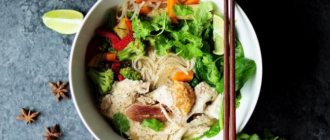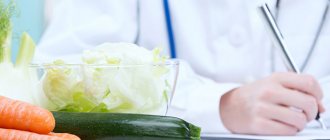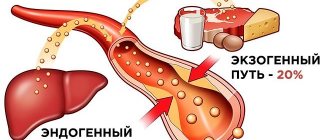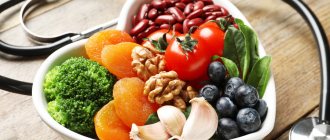High cholesterol leads to vascular and heart diseases
Drugs to lower blood cholesterol are often prescribed to people with heart and vascular diseases. These are the most common diseases.
Unfortunately, these diseases lead to strokes and heart attacks, and in severe cases this leads to very serious consequences. Nowadays, a heart attack or stroke is not only a disease of older people. Such pathologies occur in people under 40 years of age. Of course, these statistics are influenced by many factors, but one of the most common is cholesterol, namely elevated levels in the blood.
It can increase due to an unhealthy lifestyle, insufficient physical activity and poor diet. To bring the indicators back to normal, doctors prescribe drugs that lower cholesterol.
Oatmeal, oat bran and fiber-rich foods
Oatmeal contains soluble fiber, which lowers low-density lipoprotein (LDL) levels, the so-called “bad” cholesterol. Soluble fiber is also found in beans, apples, pears, barley and prunes.
Soluble fiber can lower the amount of cholesterol in the blood. 5-10 grams or more of soluble fiber per day reduces total cholesterol and LDL cholesterol. One and a half cups of oatmeal contains 6 grams of fiber. If you add some fruit, such as banana, to your porridge, you'll get about 4 more grams of fiber. For variety, try unprocessed oats or rolled oats containing oat groats or oat bran.
Complications from high cholesterol
High cholesterol is dangerous because it increases the likelihood of developing the following diseases:
- atherosclerosis – accompanied by the formation of atherosclerotic plaques, decreased elasticity of vessel walls, and narrowing of the arteries;
- coronary heart disease – accompanied by narrowing of the coronary artery, which causes myocardial hypoxia and disrupts its functioning;
- hypertension - manifests itself as high blood pressure, against the background of which stroke, heart attack, heart failure and other serious complications are likely;
- stroke - an acute disorder of cerebral circulation as a result of blockage or rupture of a cerebral vessel;
- heart attack – death of a section of the heart muscle due to loss of blood supply.
Most of these diseases are known to be fatal.
High cholesterol at a young age causes early disability and mortality. Due to the increased concentration of LDL, the walls of blood vessels become less elastic, atherosclerotic plaques are deposited on them, which impede blood flow. As a result, blood clots form, which cause heart attack and stroke.
Signs of High Cholesterol:
- heart pain, angina attacks;
- heaviness, pain in the legs even after minor physical exertion;
- the appearance of blood clots with mild bleeding;
- yellow spots on the skin, mainly in the eye area, wen.
More severe symptoms of high cholesterol in men and women appear when LDL levels are at critical levels. This may be a pre-stroke or pre-infarction condition.
The earlier high cholesterol and its causes are identified, the more effective the treatment.
Fish and omega-3 fatty acids
Fish and omega 3 fatty acids
Eating fatty fish is good for your heart because it contains high amounts of omega-3 fatty acids, which reduce blood pressure and the risk of blood clots. In people who have had heart attacks, fish oil and omega-3 fatty acids reduce the risk of sudden death.
Cardiologists recommend eating at least 2 servings of fish per week. The largest amounts of omega-3 fatty acids contain:
- mackerel;
- river trout;
- herring;
- sardines;
- longfin tuna;
- salmon;
- halibut.
To avoid adding unhealthy fats, fish should be baked or grilled. If you don't like fish, you can get some omega-3 fatty acids from foods like flaxseed meal, camelina oil, or canola oil.
Another option is to take omega-3 fatty acid or fish oil supplements, but then you won't get other nutrients that fish also contain (such as selenium). If you plan to use such supplements, please consult your physician first.
When are medications prescribed to lower blood cholesterol?
Cholesterol-lowering medications must be prescribed by a doctor
These drugs can only be prescribed by the attending physician and only after undergoing tests. The thing is that there is no single standard for cholesterol; it depends primarily on age and gender.
In addition, this indicator can be influenced by other factors, so making decisions on your own and prescribing medications is prohibited.
Regarding control and timely detection of deviations in these indicators, a person must take tests once a year. But if a person belongs to a risk group, then tests should be taken 2-3 times a year.
Depending on the results, the attending physician prescribes tablets, indicates dosages and gives recommendations. You cannot change anything on your own; the progress of treatment is monitored by a doctor.
Walnuts, almonds and other nuts
Benefits of nuts
Walnuts, almonds and other nuts can improve your cholesterol levels. Rich in mono- and polyunsaturated fatty acids, walnuts also help support vascular health.
Eating a handful of almost any type of nut (almonds, hazelnuts, peanuts, pecans, pine nuts, pistachios, walnuts) daily can reduce your risk of heart disease. When choosing nuts, make sure that they are without added salt or sugar.
All nuts are high in calories, so a handful (40-45 g) will be enough. To avoid overeating and weight gain, replace foods rich in saturated fat with nuts. For example, instead of cheese, meat or croutons, add a handful of walnuts or almonds to your salad.
What you need to know about cholesterol?
The content of the article
Cholesterol is a lipoprotein. Lipoprotein is a combination of fats and proteins. Most of the cholesterol (80%) is produced in the liver, 20% of it enters the body with food. A person needs no more than 300 mg of cholesterol per day.
Cholesterol performs several important functions:
- responsible for the formation of cell membranes, maintaining their strength and elasticity;
- participates in the production of bile by the liver;
- participates in the synthesis of vitamin D;
- participates in the synthesis of sex hormones;
- protects the nervous system;
- participates in metabolic processes.
Olive oil
The benefits of olive oil
Another good source of MUFA is olive oil.
To benefit your heart, try to consume 2 tablespoons (23 g) of olive oil daily, replacing other fats. You can sauté vegetables in olive oil, add it to marinades, or mix it with vinegar for salad dressings. When frying meat, use olive oil instead of butter.
Both avocados and olive oil are high-calorie foods, so don't eat more than the recommended amount.
Traditional methods of treatment
It will be difficult to quickly lower cholesterol levels only with the help of traditional methods if you do not follow a diet, continue to drink and smoke, and spend most of the day on the couch. But with an integrated approach, recipes from the folk piggy bank can be a good help in combating the problem:
- dandelion root - a powder is prepared from dried raw materials, then a teaspoon is consumed before each meal during the day. A course of six months is enough to feel improvement;
- propolis tincture – 4% composition helps to cleanse blood vessels and reduce blood cholesterol levels if you mix 7 drops of tincture with a glass of water and drink half an hour before meals;
- licorice root - many people know this ingredient as being present in cough recipes. In this case, a two-month course of treatment will help get rid of excess cholesterol. 2 tablespoons of raw material are crushed and boiled for 10 minutes in 500 ml of water, then drunk in a course of 2-3 weeks, a third of a glass three times a day. After a month of break, the course is repeated;
- white cinquefoil root - cut it into pieces, pour 50 g. raw materials with two glasses of vodka and leave in a dark place for two weeks, shaking constantly. You should drink 25 drops before meals for 30 days. After a ten-day break, if the infusion is over, you need to add another glass of vodka, but take 25 drops over the next 14 days;
- tincture of hawthorn flowers - 4 tablespoons of flowers are poured with a glass of alcohol and infused for 10 days. The finished composition is consumed first by 5 drops, increasing the dose by 5 drops daily. When it reaches 100, you need to drink the infusion in the reverse order, gradually reaching the original five drops.
A mixture of lemons, horseradish root and garlic is good for removing high cholesterol.
You need to take 250 grams. lemon, garlic and horseradish root, grind everything in a meat grinder (lemons with skin), pour a glass of cool water and leave overnight to infuse. Take the prepared mixture one tablespoon at a time, with a small amount of honey, three times a day before eating. This recipe is not suitable for people suffering from stomach and intestinal diseases.
Products with added plant sterols and stanols
Products are available that are fortified with sterols or stanols, plant substances that block the absorption of cholesterol.
Some margarines, orange juice and drinking yogurts with added plant sterols can reduce LDL levels by 5-15%. To see results, you need to consume at least 2 grams of plant sterols per day, which equates to about 2 glasses of sterol-fortified orange juice.
It is unclear whether foods containing plant sterols and stanols reduce the risk of heart attacks and strokes, although experts believe that cholesterol-lowering foods also reduce the risk of cardiovascular complications. Plant sterols and stanols do not affect the level of triglycerides and high-density lipoproteins (HDL), the so-called “good” cholesterol.
Cholesterol: lowering cannot be increasing
Do you know why Americans are considered aggressive and assertive? Their blood cholesterol levels are on average significantly lower than those of Europeans. Scientists are already clear: the zeal that we show on the fronts of the war against cholesterol is unnecessary and sometimes even harmful. It's time to reconsider the strategy and tactics of the cholesterol wars!
GUILTY, BUT NOT VERY GUILTY
A recent statement from doctors sounds sensational: there is no direct connection between high cholesterol levels and cardiovascular diseases!
Doubts about this have always existed, but in the late 90s unexpected research data appeared. It turned out that lowering cholesterol with the help of powerful drugs - statins, reduces the risk of cardiovascular diseases only at first, when its level drops by 10-20%. Then no matter what you do, the risk no longer decreases. Some scientists even suggest that the positive effect is achieved not at all by lowering cholesterol, but due to other effects that statins have.
There are already many such studies. It turns out to be a paradoxical situation: just yesterday we were called upon to suppress cholesterol by all possible means, almost to the level of a rabbit (the norm for rodents is 50 mg/dL, for humans – 200 mg/dL).
There is no point in reducing blood cholesterol levels by more than 20%.
Cholesterol is just one of the risk factors for atherosclerosis, although it is the most important. Observational data show: the higher the average cholesterol in a population, the higher the incidence of cardiovascular diseases. High cholesterol.
SEARCHING FOR THE ENEMY
If you lower cholesterol, this does not mean that you are thereby fighting atherosclerosis. A bear, for example, has a normal cholesterol level that is 2 times higher than a human, and atherosclerosis, however, is not the most common disease among clubfoot.
It is not the cholesterol in the blood that is dangerous, but the cholesterol that settles on the walls of blood vessels, forming plaques. Especially in combination with other lipid metabolism disorders: high levels of triglycerides in the blood or low levels of cholesterol carriers - high-density lipoproteins (HDL). Each of these disorders provokes atherosclerosis.
It makes no sense to fight cholesterol as such and get too carried away with this war. The body cannot exist without cholesterol - it is its building material. All cellular structures and tissues of the brain contain cholesterol; it is the precursor of all steroid hormones; without it, the central nervous system cannot function.
But you still need to try to maintain its level within the normal range. In most cases, this can be achieved with diet. Doctors agreed to consider 5.2 mmol/l (200 mg/dl) as the norm. For most, this figure is a dream: the average cholesterol level among Russians is 240 mg/dl.
The cholesterol level is 5.2 mmol/l (200 mg/dl).
WE CARRY OUT EXPLORATION
The only way to find out how high your cholesterol levels are is with a blood test. It is advisable for men to have it done for the first time at the age of 35-40, especially if there are additional risk factors - smoking, diabetes, hypertension (but excess weight is considered not such an important factor). Women are advised to have their cholesterol levels checked as they approach menopause.
Can you trust the analysis? Not long ago, experts assessed the accuracy of determining blood lipids in the laboratories of regular clinics. It turned out that 80% of them make large errors. Therefore, it is better to contact laboratories certified by the All-Russian Certification Center.
There is another way: ask what method is used to determine cholesterol levels in the laboratory - if it is enzymatic, then you can assume that the analysis will be quite accurate. But keep in mind that this method is expensive, and therefore you will have to pay for it. The biggest doubts should arise from free tests: they are performed using the most ancient, cheapest and most inaccurate method.
INCREASED CHOLESTEROL
So, you know your blood cholesterol level and now you must decide whether you need to change something in your life or not.
If your cholesterol level is 240-250 mg/dL (or 6 mmol/L), it's worth considering whether you're eating right. Especially if you have other risk factors for heart disease. However, there is no need to take emergency measures.
If the cholesterol level is 280-300 mg/dl (7-7.5 mmol/l), you need to take decisive action. But under no circumstances should you reach for medications – after all, in principle, you are still quite healthy. To stay that way, it is vital to change your lifestyle: move more, eat less and watch what you eat. You need to monitor your results monthly for the first 2-4 months to assess the effectiveness of your diet.
HOW TO LOWER CHOLESTEROL CHOLESTEROL DIET
- No sandwiches. Try to sharply reduce your butter consumption, ideally switch to vegetable oil. This one step can often bring your cholesterol levels to an acceptable level of 240 mg/dL in just 2-4 weeks.
- Soy instead of cheese. It would also be good to give up cream, sour cream, fatty cheeses and eggs, and at the same time quit smoking. Switching to soy products is very beneficial. This is a protein diet that helps fight excess weight and replaces cholesterol-containing concentrated dairy products.
- Lard lovers should remember that it is very rich in cholesterol. Its consumption must be compensated by eating vegetable oil and fatty fish. It is good to eat lard with garlic: it helps to utilize fats faster.
- Maintain a balance of fats - saturated (animal), monounsaturated and polyunsaturated - there should be a third of them in the diet. In other words, every “eaten piece” of animal fat must be compensated with vegetable fats. You can do this: mix olive, sunflower (or corn) and soybean oils in equal parts and add this balanced mixture to salads, cereals and pasta. DIET FOR HIGH CHOLESTEROL
Walnuts do not help lower cholesterol!
* If there is little HDL (high-density lipoprotein that carries cholesterol) in the blood, substances contained in red grapes will help increase their levels. This is the effect that data on the benefits of moderate consumption of red wine is based on - but juice is also quite suitable!
* If your HDL cholesterol is more than 300-320 mg/dL (8-10 mmol/L) cholesterol, it is better not to try to cope with the problem on your own. A doctor must understand the reasons for such a serious violation.
If dietary cholesterol is to blame, the only thing that will help is diet. But there are other, more serious violations. For example, genetic: the gene responsible for lipid metabolism has broken down. But such defects, as a rule, make themselves felt in childhood and are very rare.
ANTI-CHOLESTEROL MEDICATION ANTI-CHOLESTEROL MEDICATION
Another way to reduce cholesterol from the borderline value of 240-320 mg/dl is dietary supplements. More precisely, not a method, but a help: Dietary supplements are not medicines and will not do a miracle. In addition, you can only take those whose effectiveness has been confirmed by studies, preferably double, placebo-controlled ones. This is important because there are many dietary supplements on the market, and serious research has been carried out on only a few of them.
Conventionally, dietary supplements that control cholesterol levels can be divided into three groups:
- improve lipid metabolism (they contain garlic extract);
- preventing the absorption of dietary fat in the intestines (based on crustacean chitin);
- specialty foods (eg wheat germ oil and fish oil).
STATINS FOR CHOLESTEROL
The last weapon is drugs: statins and fibrates. They block internal cholesterol synthesis. They should be taken only on the advice of a doctor, when the diet does not give the desired result even with the most severe restrictions.
Once you start taking statins, you will have to take them for life. Withdrawal within a few days will bring cholesterol levels back to the original levels, if not higher. In addition, statins are known for their side effects: for example, they can provoke severe depression. And they are not a gift for the liver. The harm of statins
And recently, scientists found that statins can replace... ordinary apples!
In developed countries, statins are prescribed for secondary prevention of heart attacks or other vascular pathologies. For example, a person has had a heart attack or coronary artery bypass surgery, has high cholesterol, plus there is another risk factor - old age, male gender, diabetes or hypertension - then the prescription of statins is justified. In all other cases, it’s shooting sparrows from a cannon.
| JUICES AGAINST CHOLESTEROL Once upon a time, nutritionists were thinking about how to fight cellulite with the help of juices. We developed a course - and it turned out that it perfectly helps lower cholesterol. Day 1: carrot juice - 130 g, celery root juice - 75 g. Day 2: carrot juice - 100 g, beet juice - 70 g (keep in the refrigerator for 1.5-2 hours before drinking), cucumber juice - 70 g. Day 3: carrot juice - 130 g, celery juice - 70 g, apple juice - 70 g. Day 4: carrot juice - 130 g, cabbage juice - 50 g. Day 5: orange juice - 130 g. There is no need to strictly follow the sequence of taking juices; one can be replaced with another. The main thing is that juices should be freshly squeezed and stored for no more than 2-3 hours. Before drinking, be sure to shake the contents of the glass: the sediment at the bottom is the most beneficial. |
Author: Olga Smirnova Published: February 17, 2021
Other dietary changes
For these products to really be beneficial, you will have to reconsider your diet and adjust your lifestyle.
Although the benefits of some types of fats were discussed above, the consumption of others - saturated fats and trans fats - should be limited. Saturated fats, found in meats, butter, cheese and other full-fat dairy products, as well as some vegetable oils, raise total cholesterol levels. Trans fats, often used in margarines or store-bought cookies, crackers or cakes, are especially unhealthy. They increase LDL and decrease HDL - the so-called. “good” cholesterol. If a product label says “partially hydrogenated oils,” the product contains trans fats and is best avoided.
In addition to changing your diet, you should also adjust your overall lifestyle - this is the key to improving your cholesterol levels. Exercise, quitting smoking and maintaining a healthy weight will help you normalize your cholesterol levels.
Make an appointment Do not self-medicate. Contact our specialists who will correctly diagnose and prescribe treatment.
Summing up
Increasing cholesterol is a process that is not always noticeable even to the person himself. At first, you are worried about excessive fatigue, memory impairment, and the inability to spend a long time in physical stress. As plaques form on the walls of the capillaries, headaches, chronic fatigue, sleep disturbances and pressure surges occur.
You need to start getting rid of such symptoms immediately and using an integrated approach. It is recommended to immediately visit a specialist, donate blood for a detailed analysis, and then follow the doctor’s advice, follow a diet, give up bad habits and take prescribed medications.
Contraindications and precautions
It should be understood that herbal medicine cannot be safe in all cases of use. Various side effects often develop, including:
- Allergic reactions. They can occur through any mechanism: from banal urticaria or skin itching to a deadly condition - anaphylactic shock, when seconds count.
- Destructive effects on the fetus during pregnancy. Many components easily penetrate the feto-placental barrier and have a teratogenic or even mutagenic effect on the developing child, provoking the development of a wide range of anomalies and deformities.
Most drugs can lower blood pressure and sugar levels, “liquefy” plasma with formed elements, and inhibit the effectiveness of the bicarbonate barrier of the gastric mucosa. Thus, absolute contraindications include the following conditions:
- Hypotension of any kind (including orthostatic).
- Hypoglycemic conditions (plants should not be taken if there are particular inadequate reactions to insulin administration).
- Severe dysfunction of the liver and kidneys, in which the elimination of toxic metabolic products slows down.
- Acute (or exacerbation of chronic) inflammatory diseases of any part of the gastrointestinal tract.
- Peptic ulcer of the stomach and duodenum.
- Calculous cholecystitis, even in remission.
- Individual hypersensitivity to certain plant elements.
- Conditions accompanied by changes in the rheological properties of plasma with formed elements according to the type of hypocoagulation. The group includes: leukemia, hemorrhagic syndrome.
Considering the significant list of contraindications and adverse reactions, it is imperative to consult with a specialist before starting a course of therapy. You should also read the instructions yourself.
Drug combinations
In addition to using the drugs separately, they can be combined together to enhance the lipid-lowering effect. Sometimes statins need help fighting high cholesterol. Taking statins can be combined with the use of drugs that intensively remove bile acids from the body. Statins are also combined with drugs that inhibit cholesterol absorption or a PCSK9 inhibitor. Statins are the base drug in all drug combinations. The decision to use drugs together is made by the doctor[2].
Menu (Power Mode)
The cholesterol diet menu is designed for 5 meals a day. Since you should not allow yourself to feel hungry during the day or in the evening, you are allowed to eat an apple, grapefruit, carrots or drink a fermented milk product. A sample menu for several days might look like this:
First option
| Breakfast |
|
| Lunch |
|
| Dinner |
|
| Afternoon snack |
|
| Dinner |
|
Second option
| Breakfast |
|
| Lunch |
|
| Dinner |
|
| Afternoon snack |
|
| Dinner |
|
Third option
| Breakfast |
|
| Lunch |
|
| Dinner |
|
| Afternoon snack |
|
| Dinner |
|
Below is a table of low-cholesterol foods that can be included in your diet.
| Products name | Featured | Prohibited |
| Fish | Lean sea fish (hake, blue whiting, pollock, navaga, pollock, haddock) and pike three times a week. | Salmon, mackerel, sardine, eel, mackerel, herring, oysters, caviar, shrimp, prepared fish, river fish in limited quantities. |
| Eggs | Up to 3 pieces per week. | Egg yolk. |
| Fats | Sunflower, corn, olive or soybean oils, up to 2 tablespoons per day. | Lard, margarine, palm and coconut oil, butter, animal fat. |
| Meat | Veal, rabbit, turkey, chicken, lean beef once or twice a week. The bird is allowed without skin. | Pork, fatty beef, fatty lamb, duck and goose meat, sausages, liver, kidneys, brain pates, sausages, sausages. |
| Dairy | Skim milk, low-fat kefir, yogurt, cheeses up to 20%, low-fat cottage cheese. | Full-fat cottage cheese, sour cream, cream, ice cream, curd mass, condensed milk, processed cheese. |
| Vegetables | Fresh and frozen, corn and beans. | Potatoes and potato snacks. |
| Fruits | Everything except banana and grapes, as well as dried fruits. | Sugared fruits, pistachios and peanuts, hazelnuts. |
| Cereals | Whole grain bread, brown rice, oatmeal, whole grain pasta. | White rice, semolina, limit buckwheat. |
| Bakery | Oatmeal cookies, bread rolls, dry cookies, “Fitness” cookies. | Biscuits, pastries, rolls, cakes, puff pastry products. |
| Sweets | Low-fat puddings, jellies without added sugar, fruit ice cream. | Chocolate, pastry cream, toffee, marmalade, pastille, sugar, syrups. |
| Beverages | Sugar-free juices, green tea, weak coffee, still mineral water. | Cocoa with milk, coffee with cream, alcoholic and sweet carbonated drinks. |
Table of prohibited products
| Proteins, g | Fats, g | Carbohydrates, g | Calories, kcal | |
| Fruits | ||||
| bananas | 1,5 | 0,2 | 21,8 | 95 |
| Nuts and dried fruits | ||||
| raisin | 2,9 | 0,6 | 66,0 | 264 |
| Cereals and porridges | ||||
| semolina | 10,3 | 1,0 | 73,3 | 328 |
| white rice | 6,7 | 0,7 | 78,9 | 344 |
| Flour and pasta | ||||
| pasta | 10,4 | 1,1 | 69,7 | 337 |
| Bakery products | ||||
| bagels | 16,0 | 1,0 | 70,0 | 336 |
| bagels | 16,0 | 1,0 | 70,0 | 336 |
| crackers | 11,2 | 1,4 | 72,2 | 331 |
| Confectionery | ||||
| jam | 0,3 | 0,2 | 63,0 | 263 |
| jam | 0,3 | 0,1 | 56,0 | 238 |
| candies | 4,3 | 19,8 | 67,5 | 453 |
| pastry cream | 0,2 | 26,0 | 16,5 | 300 |
| Ice cream | ||||
| ice cream | 3,7 | 6,9 | 22,1 | 189 |
| Cakes | ||||
| cake | 4,4 | 23,4 | 45,2 | 407 |
| Chocolate | ||||
| chocolate | 5,4 | 35,3 | 56,5 | 544 |
| Raw materials and seasonings | ||||
| ketchup | 1,8 | 1,0 | 22,2 | 93 |
| mayonnaise | 2,4 | 67,0 | 3,9 | 627 |
| Dairy | ||||
| cream | 2,8 | 20,0 | 3,7 | 205 |
| sour cream 30% | 2,4 | 30,0 | 3,1 | 294 |
| sour cream 40% (fat) | 2,4 | 40,0 | 2,6 | 381 |
| Cheeses and cottage cheese | ||||
| cheese | 24,1 | 29,5 | 0,3 | 363 |
| cottage cheese 18% (fat) | 14,0 | 18,0 | 2,8 | 232 |
| Meat products | ||||
| pork | 16,0 | 21,6 | 0,0 | 259 |
| pork liver | 18,8 | 3,6 | 0,0 | 108 |
| pork kidneys | 13,0 | 3,1 | 0,0 | 80 |
| pork fat | 1,4 | 92,8 | 0,0 | 841 |
| salo | 2,4 | 89,0 | 0,0 | 797 |
| beef liver | 17,4 | 3,1 | 0,0 | 98 |
| beef kidneys | 12,5 | 1,8 | 0,0 | 66 |
| beef brains | 9,5 | 9,5 | 0,0 | 124 |
| mutton | 15,6 | 16,3 | 0,0 | 209 |
| Sausages | ||||
| smoked sausage | 16,2 | 44,6 | 0,0 | 466 |
| smoked sausage | 9,9 | 63,2 | 0,3 | 608 |
| sausages | 10,1 | 31,6 | 1,9 | 332 |
| sausages | 12,3 | 25,3 | 0,0 | 277 |
| Bird | ||||
| smoked chicken | 27,5 | 8,2 | 0,0 | 184 |
| duck | 16,5 | 61,2 | 0,0 | 346 |
| smoked duck | 19,0 | 28,4 | 0,0 | 337 |
| goose | 16,1 | 33,3 | 0,0 | 364 |
| Fish and seafood | ||||
| smoked fish | 26,8 | 9,9 | 0,0 | 196 |
| salted fish | 19,2 | 2,0 | 0,0 | 190 |
| Red caviar | 32,0 | 15,0 | 0,0 | 263 |
| black caviar | 28,0 | 9,7 | 0,0 | 203 |
| squid | 21,2 | 2,8 | 2,0 | 122 |
| shrimps | 22,0 | 1,0 | 0,0 | 97 |
| salmon | 19,8 | 6,3 | 0,0 | 142 |
| sturgeon | 16,4 | 10,9 | 0,0 | 163 |
| canned fish | 17,5 | 2,0 | 0,0 | 88 |
| semi-finished fish products | 12,5 | 6,7 | 14,7 | 209 |
| sardine | 20,6 | 9,6 | — | 169 |
| mackerel | 18,0 | 13,2 | 0,0 | 191 |
| cod (liver in oil) | 4,2 | 65,7 | 1,2 | 613 |
| boiled oysters | 14,0 | 3,0 | — | 95 |
| fresh oysters | 14,0 | 6,0 | 0,3 | 95 |
| Oils and fats | ||||
| butter | 0,5 | 82,5 | 0,8 | 748 |
| creamy margarine | 0,5 | 82,0 | 0,0 | 745 |
| coconut oil | 0,0 | 99,9 | 0,0 | 899 |
| palm oil | 0,0 | 99,9 | 0,0 | 899 |
| rendered beef fat | 0,0 | 99,7 | 0,0 | 897 |
| cooking fat | 0,0 | 99,7 | 0,0 | 897 |
| rendered pork fat | 0,0 | 99,6 | 0,0 | 896 |
| Non-alcoholic drinks | ||||
| cola | 0,0 | 0,0 | 10,4 | 42 |
| lemonade | 0,0 | 0,0 | 6,4 | 26 |
| Pepsi | 0,0 | 0,0 | 8,7 | 38 |
| sprite | 0,1 | 0,0 | 7,0 | 29 |
*data is per 100 g of product
Helpful tips for fighting cholesterol
In addition to proper nutrition, several simple actions that can become a good tradition can reduce the amount of cholesterol in the blood.
Increase the amount of physical activity, physical activity and sports. Choose loads that are suitable for your age and health. Those who don't exercise at all can start with leisurely walks, then move on to brisk walking and eventually start running.
Give up bad habits. Minimize the amount of alcohol and tobacco in your life. In addition to affecting the heart and vascular system, these addictions also negatively affect other organs.
Author: Di&Di Corporation
Causes of very low cholesterol
Causes of very low cholesterol may include:
- acute infections;
- sepsis;
- extensive burns;
- fasting and a very strict diet;
- eating too many fatty acids (omegas).
Very low cholesterol can be a sign of diseases:
- hypolipoproteinemia;
- hyperthyroidism;
- liver cancer and other oncological diseases;
- liver cirrhosis, especially in the later stages;
- chronic anemia;
- bone marrow pathologies;
- chronic pulmonary pathology.
Fibrates
One of the ways to reduce the amount of lipids in the body is to increase their breakdown. This can be achieved by playing sports - physical activity leads to a decrease in body fat reserves [2]. Another way is to enhance the process of lipid breakdown with drugs.
Fibrates are drugs that can stimulate the breakdown of lipid molecules inside cells [2] [3]. The amount of lipids in cells decreases, and they are forced to take fats from the blood for their own needs. The amount of LDL-C decreases the most.
Table of permitted products
| Proteins, g | Fats, g | Carbohydrates, g | Calories, kcal | |
| Vegetables and greens | ||||
| eggplant | 1,2 | 0,1 | 4,5 | 24 |
| beans | 6,0 | 0,1 | 8,5 | 57 |
| zucchini | 0,6 | 0,3 | 4,6 | 24 |
| cabbage | 1,8 | 0,1 | 4,7 | 27 |
| broccoli | 3,0 | 0,4 | 5,2 | 28 |
| Brussels sprouts | 4,8 | 0,0 | 8,0 | 43 |
| cauliflower | 2,5 | 0,3 | 5,4 | 30 |
| green onion | 1,3 | 0,0 | 4,6 | 19 |
| bulb onions | 1,4 | 0,0 | 10,4 | 41 |
| carrot | 1,3 | 0,1 | 6,9 | 32 |
| cucumbers | 0,8 | 0,1 | 2,8 | 15 |
| squash | 0,6 | 0,1 | 4,3 | 19 |
| salad pepper | 1,3 | 0,0 | 5,3 | 27 |
| parsley | 3,7 | 0,4 | 7,6 | 47 |
| salad | 1,2 | 0,3 | 1,3 | 12 |
| beet | 1,5 | 0,1 | 8,8 | 40 |
| celery | 0,9 | 0,1 | 2,1 | 12 |
| soybeans | 34,9 | 17,3 | 17,3 | 381 |
| asparagus | 1,9 | 0,1 | 3,1 | 20 |
| tomatoes | 0,6 | 0,2 | 4,2 | 20 |
| Jerusalem artichoke | 2,1 | 0,1 | 12,8 | 61 |
| pumpkin | 1,3 | 0,3 | 7,7 | 28 |
| dill | 2,5 | 0,5 | 6,3 | 38 |
| beans | 7,8 | 0,5 | 21,5 | 123 |
| garlic | 6,5 | 0,5 | 29,9 | 143 |
| lentils | 24,0 | 1,5 | 42,7 | 284 |
| Fruits | ||||
| avocado | 2,0 | 20,0 | 7,4 | 208 |
| oranges | 0,9 | 0,2 | 8,1 | 36 |
| pomegranate | 0,9 | 0,0 | 13,9 | 52 |
| grapefruit | 0,7 | 0,2 | 6,5 | 29 |
| pears | 0,4 | 0,3 | 10,9 | 42 |
| lemons | 0,9 | 0,1 | 3,0 | 16 |
| mango | 0,5 | 0,3 | 11,5 | 67 |
| tangerines | 0,8 | 0,2 | 7,5 | 33 |
| nectarine | 0,9 | 0,2 | 11,8 | 48 |
| peaches | 0,9 | 0,1 | 11,3 | 46 |
| apples | 0,4 | 0,4 | 9,8 | 47 |
| Berries | ||||
| gooseberry | 0,7 | 0,2 | 12,0 | 43 |
| Red currants | 0,6 | 0,2 | 7,7 | 43 |
| black currant | 1,0 | 0,4 | 7,3 | 44 |
| Nuts and dried fruits | ||||
| nuts | 15,0 | 40,0 | 20,0 | 500 |
| almond | 18,6 | 57,7 | 16,2 | 645 |
| flax seeds | 18,3 | 42,2 | 28,9 | 534 |
| fenugreek seeds | 23,0 | 6,4 | 58,3 | 323 |
| sunflower seeds | 20,7 | 52,9 | 3,4 | 578 |
| Cereals and porridges | ||||
| buckwheat (kernel) | 12,6 | 3,3 | 62,1 | 313 |
| oat groats | 12,3 | 6,1 | 59,5 | 342 |
| cereals | 11,9 | 7,2 | 69,3 | 366 |
| wheat bran | 15,1 | 3,8 | 53,6 | 296 |
| Raw materials and seasonings | ||||
| basil | 2,5 | 0,6 | 4,3 | 27 |
| honey | 0,8 | 0,0 | 81,5 | 329 |
| Dairy | ||||
| kefir 0% | 3,0 | 0,1 | 3,8 | 30 |
| kefir 1% | 2,8 | 1,0 | 4,0 | 40 |
| Cheeses and cottage cheese | ||||
| cottage cheese 0.6% (low fat) | 18,0 | 0,6 | 1,8 | 88 |
| curd tofu | 8,1 | 4,2 | 0,6 | 73 |
| Meat products | ||||
| beef | 18,9 | 19,4 | 0,0 | 187 |
| Bird | ||||
| chicken fillet | 23,1 | 1,2 | 0,0 | 110 |
| turkey | 19,2 | 0,7 | 0,0 | 84 |
| Eggs | ||||
| eggs | 12,7 | 10,9 | 0,7 | 157 |
| Fish and seafood | ||||
| fish | 18,5 | 4,9 | 0,0 | 136 |
| seaweed | 0,8 | 5,1 | 0,0 | 49 |
| Oils and fats | ||||
| grape seed oil | 0,0 | 99,9 | 0,0 | 899 |
| linseed oil | 0,0 | 99,8 | 0,0 | 898 |
| olive oil | 0,0 | 99,8 | 0,0 | 898 |
| sunflower oil | 0,0 | 99,9 | 0,0 | 899 |
| Non-alcoholic drinks | ||||
| mineral water | 0,0 | 0,0 | 0,0 | — |
| instant chicory | 0,1 | 0,0 | 2,8 | 11 |
| green tea | 0,0 | 0,0 | 0,0 | — |
* data is per 100 g of product









